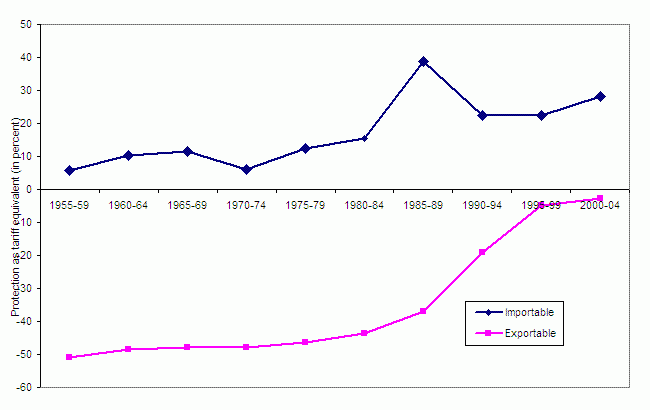The recent increases in food prices appear to have put millions of people at risk of poverty. Poor people remain vulnerable to food price increases because they spend such a large fraction of their incomes on staple foods. Even in rural areas, many poor people do not benefit from rising food prices either because they are not farmers, or because they are farmers who produce only some of their family’s needs, and purchase the remainder. While we cannot be sure of the overall impact of the food price increases on poverty until we have post-crisis household survey data available, our ex ante analysis (Ivanic and Martin 2008) and that of other researchers such as Wodon and Zaman (2008) suggest that the net effect of the recent food price rises was to increase poverty rates in many low income countries.
One tempting response to the crisis is to conclude that the problem is one of inadequate food production in poor countries, perhaps—as has frequently been argued—because the structural adjustment policies of the World Bank and the IMF reduced agricultural protection in developing countries. Clearly, if food production in poor countries were higher, these countries would be less dependent on imports of food and more self-sufficient. But would their people be more food secure?
Did liberalisation cause the problem?
There are undoubtedly specific instances in which developing countries have liberalised imports, and imports have, as a consequence, replaced domestic production of food. If this were the general case, we would expect average rates of agricultural protection in developing countries to have declined from initially positive levels.
A new study of agricultural protection led by Kym Anderson (2009) allows us to examine this question using protection data for a large number of developing countries. These data are clearly inconsistent with the idea that liberalisation caused declines in output and in self-sufficiency. Rather than declining, protection to import-competing agriculture actually rose between the 1970s and the early 2000s. Protection to imported agricultural goods has increased from under 10% to close to 30% since the 1970s. The output-suppressing taxation of export-oriented agriculture declined from around 50% to close to zero today, reducing the pull of resources out of agriculture.
Figure 1 Protection to agricultural goods by trade status, developing countries, %
Would people be more food secure if their countries were more self-sufficient?
Increased agricultural protection in developing countries would undoubtedly increase self-sufficiency in agricultural products. However, the impact on food security may be quite different. Amartya Sen’s (1981) path-breaking study clarified the distinction between self-sufficiency and food security. He showed that the critical element for food security is whether individuals have access to food, rather than whether food is produced in sufficient quantity in a country or region. In the absence of safety-net programs that give individuals entitlements to food that exceed what they can buy in the market, access to food comes down to whether people have sufficient income to buy food. In this situation, the impact of a change in food prices on real incomes, and particularly on poverty rates, becomes a critical determinant of food security.
Our recent work (Ivanic and Martin 2008) concludes that the large rises in food prices between 2005 and the first quarter of 2008 probably had sharply adverse impacts on poverty in low-income countries. Using very simple techniques, we estimated that poverty at the traditional $1 per day level increased by around 100 million people as a result of the increased prices of staple foods in the absence of safety-net programs1. A large number of other ex ante studies of the poverty impacts of food price rises have since appeared and virtually all find substantial net increases in poverty rates when prices of staple food prices rise. See, for example, Wodon and Zaman (2008) for Africa. World prices of these foods increased to even higher levels in the second quarter of 2008 but have since fallen to first-quarter levels or below.
When considering the impact of food self-sufficiency on poverty and food security, it is essential to remember that food self-sufficiency levels are endogenously determined by a range of factors, including decisions on protection rates and on agricultural investment and technology. The impact of a given change in self-sufficiency ratios on food security depends heavily upon whether it was brought about by increases in protection or by other factors such as improvements in technology or investment in public goods.
An important contribution of Tyers and Falvey (1988) was to show that a higher rate of tariff protection will change the level of self-sufficiency but will not change the overall welfare impact of a change in world prices. While simple, standard rules of thumb would suggest that a country with a higher rate of protection and a smaller import share would suffer less from an increase in world prices because of its lower import share, this need not be the case. In the protecting country, the welfare cost of an increase in prices is reinforced by a reduction in tariff revenues as subsidised output levels rise and taxed consumption levels fall, and the welfare impact of the increase in prices remains the same. At the individual household level, the introduction of tariffs on staple foods is likely to reduce food security in many poor households by raising the prices of the staple foods that form a large share of their expenditures.
By contrast, an improvement in food security brought about by improvements in agricultural productivity or rural infrastructure is much more likely to be beneficial. As long as the benefits of improved technology are available to small, poor farmers, they will benefit from the improvements in technology and consumers will be no worse off – and potentially better off if the technological improvement is sufficiently broadly distributed so as to bring consumer food prices down. Empirical research by Evenson (2001) concludes that the rates of return on investments in rural research and development, in particular, remain extremely high, suggesting that there is great potential for poverty reduction by improving the technology available to poor farmers. The persistence of these high returns suggests that governments and international agencies such as the World Bank may have been considerably under-investing in agricultural research and development in developing countries.
Short vs. long run considerations
In the long run, it is clear that the path to improving food security lies through improvements in technology that raise productivity and raise incomes. Once consumers' incomes are substantially greater than their essential food needs, they can effectively be considered “food-secure” under most conditions.
In the short run, achieving food security is a more difficult challenge. Clearly, the best approach to achieving food security in the short run is to provide social safety nets that can help deal with the problems facing poor consumers. Mechanisms such as food aid or conditional cash transfers are the most promising for several reasons – they can target those most in need, leaving the consumption and production decisions of others undistorted, and they can deal with food security challenges that are not necessarily related to changes in prices of staple foods, such as those resulting from falling farm output during droughts.
In practice, governments often respond to price-induced food prices by applying economy-wide policy instruments, such as export restrictions designed to lower domestic prices. Even when they are effective, the untargeted nature of these policies makes them less efficient than targeted policies such as social safety nets – simply because these price policies benefit poor and rich consumers without distinction, and hurt some poor net sellers of food. Further, export restrictions destabilise global markets by increasing demand and lowering supply when the price is already high. Relaxation or removal of these policies can provide significant relief. Relaxation of export restrictions by the Ukraine reduced world prices of wheat by 18% (Chauffour 2008).
Conclusions
The recent global increase in the food prices has brought hardship to many poor people in poor countries. Some have argued that this problem arises from agricultural liberalisation in poor countries, increasing imports and reducing production and self-sufficiency levels in developing countries. However, new data make clear that, on average, protection to import-competing agriculture in poor countries has been rising since the 1970s.
Protection of food staples in poor countries will certainly raise self-sufficiency levels. However, food security depends not on self-sufficiency levels but on whether poor people have access to food. Our estimates of the impact of higher food prices on poverty suggest that, in most poor countries, using protection to increase self-sufficiency is more likely to raise poverty and lower food security.
In the long run, a central goal of development policy is to raise incomes to the point where people are less vulnerable to food price changes. In the short run, policies such as social safety nets are – if feasible – more likely to be efficient and effective than measures such as export restrictions that seek to reduce domestic food prices for all people within the country.
References
Anderson, K. ed. (2009), Distortions to Agricultural Incentives: A Global Perspective, 1955 to 2007, Palgrave Macmillan and the World Bank.
Chauffour, J.P. (2008), ‘Global food price crisis: trade policy origins and options’ Trade Note 34, World Bank.
Evenson, R. (2001), ‘Economic impacts of agricultural research and extension’ Ch 11 in Evenson, R. and Pingali, P. eds. Handbook of Agricultural Economics, 1(1):573-626, North Holland, Amsterdam.
Falvey, R. and Tyers, R. (1988), ‘Border price changes in the presence of subsidized exports’ Oxford Economic Papers 41:434-51.
Ivanic, M. and Martin, W. (2008), ‘Implications of higher global food prices for poverty in low-income countries’, Agricultural Economics.
Sen, A. (1981), Poverty and Famines: an Essay on Entitlement and Deprivation, Clarendon Press, Oxford.
Wodon, Q. and Zaman, H. (2008), ‘Rising food prices in Sub-Saharan Africa: poverty impact and policy responses’ Policy Research Working Paper 4738, World Bank.
1 This is the estimated net increase in poverty after allowing for the number of net sellers of food lifted out of poverty by higher food prices. The gross number of people initially above the poverty line but pulled below this level by higher food prices would have been substantially larger.


